«»
|
|
||||||||||||||
|
||||||||||||||
|
||||||||||||||
| Contraindication: | ||||||||||||||
| This pose should not be done in the following cases: |
||||||||||||||
|
||||||||||||||
"Above the navel and below the palate respectively, are the Surya and the Chandra. The exercise, called the Viparita Karani, is learnt from the guru’s instructions." HaṭhaYoga Pradīpikā हठयोगप्रदीपिका chapter 3 verse 78 . |
||||||||||||||
++++
| Sarvāṅgāsana |
|
|
ANATOMICAL
ANALYSIS |
|
This balance pose requires good muscle tone of mainly postural ("brick") muscles (deep back muscles, buttocks muscles, abdominal muscles...) to be able to withstand the inversion of gravity.
|
|
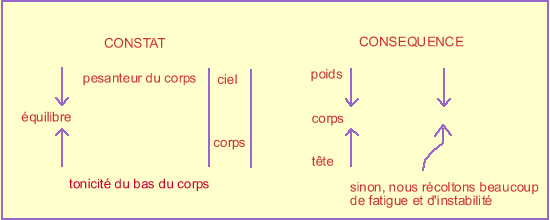 |
|
| Problems inherent to this pose 1- This pose is on the shoulders and not
on the back of the neck
Joint reflection Jaya and Claire-Lise Cotté-Garneau The osteopath’s point of view
|
|
| The weight of Sarvāṅgāsana lays on the C7-D1 hinge: risk of reversed neck curve |
A spasm of the anterior neck muscles (long muscle of the neck, deep muscles) can push C3 and other vertebrae backward and there is no physiological lordosis any more.
The ideal support |
|
Indeed, if Sarvāṅgāsana is regularly held with the back of the neck fully extended and the body weight laying more on the cervical vertebrae than on the shoulders and the back, there will soon be a risk of cervical problems, and of reversed neck curve on the medium term. Solution brought by BKS Iyengar : use of a folded blanket under the shoulders to free the cervical vertebrae.
|
|
| The
problem of kidney or back pain in the pose |
|
| This balance pose requires to find
verticality by using tone back and abdominal muscles. Holding
this pose sometimes causes lumbar pain. People
who have kidney pain in this pose, can be
reassured that most of the time, they do not have vertebral
disk problems (unless there is an already known
pathology), but rather visceral or ligament
problems, either empty organs (entrails, intestines, stomach),
or solid organs (kidneys, liver, and so on). As a matter of fact, the intervertebral disk is at risk only when
a person is standing and makes the effort to bend forward
(lumbar flexion). In shoulder stand,
the only weight is the weight of the legs, though the legs
become lighter if they are well aligned on the body’s
line of gravity. Therefore,
this pose causes no intervertebral disk problem. On the contrary, inverting the body
relieves potential tension in internal ligaments. If we have lumbar
pain in the pose, most of the time, this pain is in fact projected
visceral pain. Organs in the belly are
bound together or to internal walls by ligaments.
Due to a sedentary lifestyle, it often happens
that these ligaments fibrose and inverting the body stretches
the fibrosis. This is positive as it has corrective effects. Nevertheless,
there may be some pain occurring as these ligaments are innervated.
Thus, this pose is very beneficial to
support the visceral function (constipation, protruding belly, "organ
descent", relief of the venous return...).
|
|
| How
to maintain a straight pose |
|
The elbows should be drawn shoulder-width together. In other words, the shoulders should be open. The practitioner can exercise himself by putting a rope inside his elbows and having it tightened shoulder-width. Do not keep the rope for too long, otherwise you may have blood circulation problems (cf. Props). Hands should firmly hold the sides of the torso and be placed at the lower tips of the shoulder blades, and not at the waist (otherwise, we go into half shoulder stand (cf. Don’ts) or the variation of another inverted pose (cf. viparita karani). Benefits of Sarvangasana. People who have a slouch posture resulting in a saggy belly and a closed rib cage have trouble maintaining their organs in place around the diaphragm and are prone to saggy belly and breathing difficulties. Thanks to this pose which helps restoring physiological pressures, they find relief from their weight by strengthening the diaphragm.
|
|
|
The overweight problem |
|
|
One of the benefits of this pose is that it helps reaching optimal body weight if practiced assiduously. So don’t get discouraged. In case of weak abdominal muscles, weight can be indeed problematic when going into the pose. Namely, some people find it impossible to lift themselves up into the pose. This can also happen to much thinner people with weak muscles. If this is the case, use a wall as a support when you go up (cf. Props and How to use them). Pregnant women. This pose can be performed until the third month of pregnancy without any problems by women with little practice. The decision whether to continue practicing it will depend upon the size of the belly (which may block the diaphragm and impede breathing), but most importantly on your agility. If you are an advanced practitioner, you can go on practicing this pose as long as you feel at ease.
Laurence at eight months of pregnancy
|
|
| Our friend Claire-Lise Cotté-Garneau, osteopath in Saint-Paul - Réunion Island |
++++
|
|
|
|
|
SYMBOLISM |
|
|
"Sarvāṅgāsana is
the mother of all Āsana"
|
|
| Harmony : |
Redirecting energies toward upper chakras
Viśuddha cakra
Viśuddha cakra can be activated through Jālandharabandha जालन्धरबन्ध, Viparītakaraṇī विपरीतकरणी, Sarvāṅgāsana, and prāṇāyāma प्राणायाम techniques. Viśuddha represents the part of consciousness related to higher balance. As a symbol of purity, it is the purification center of psychosomatic functions.
|
| Sarvāṅgāsana brings harmony and joy in the body. It is a cure-all for most common disorders. This asana expresses perfect body balance, peace of mind, and the spirituality of realizing the soul in the body. When the navel area is above and the palate below, the "sun" is above and the moon below. The moon not only represents bindu बिंदु, but also consciousness. The Sun represents maṇipura cakra मणिपुर चक्र, but also PRÂNA in the body. Consciousness and Prâna thus flow faster to the brain. Usually, the gravitational force naturally draws all
body fluids toward the lower part of the body. By inverting the
body, all fluids flow back to the head. This pose enables
to redirect the energies of lower chakras
toward upper chakras.
|
|
| Energetics: |
|
| In Vēdānta Yoga योग वेदांत, the 5 prāṇa प्राण play an important role in poses. Sarvāṅgāsana activates these five prânas also called "vital airs", and, this way, controls all the organs of action. Inversion reverses the polarity of the electromagnetic field created within the upright body. The energy field generated by the electrical activity of the brain is integrated with the geomagnetic field of the earth’s surface. This has a revitalizing influence upon the human aura.
|
|
| Knowledge: |
|
| The tradition maintains that the
benefit achieved through the practice of Āsana is knowledge of the three dimensions.
These three dimensions can first be understood
through the spatial understanding of the body’s geometry.
That is to say, these dimensions can be physical, mental and spiritual, or gross,
subtle and causal.
In any case, Āsana have an effect on kōśa कोश.
As Āsana are mainly a physical experience sthūla Śarīra स्थूल शरीर,
they will affect the physical sheath, but also the pranic and mental sheaths. |
|


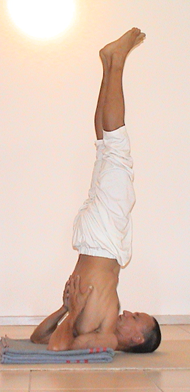
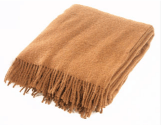
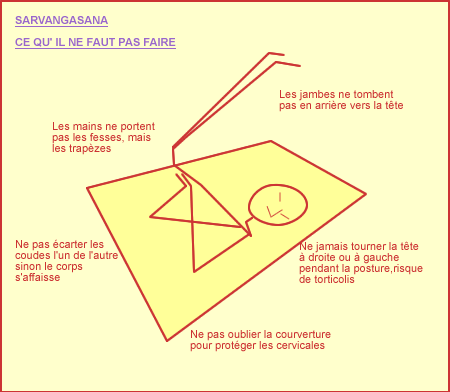

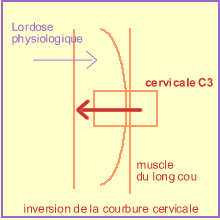
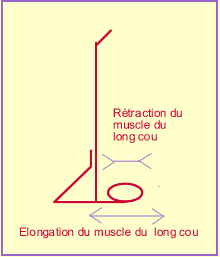
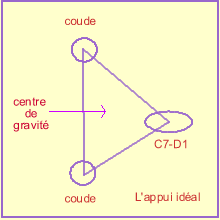
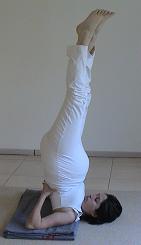
 Sarvāṅgāsana
Sarvāṅgāsana 
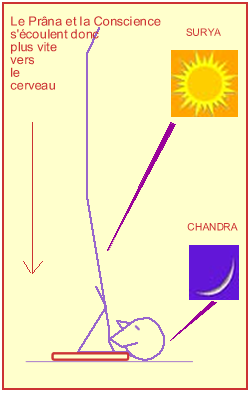
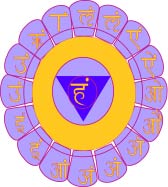
Forum posts
1. The study of an inversion, SARVĀṄGĀSANA सर्वाङ्गासन, 2 June 2022, 16:20, by Francesca Romana Brogani
I just wanted to thank you for this wonderful article , very clear and full of all the information needed for this Asana. A lot of articles and books talk about "the mother " of all the Asana , as Master Iyengar said , but this completeness and depth of every aspect is really rare. Thank you so much.